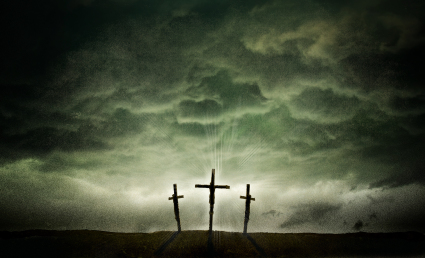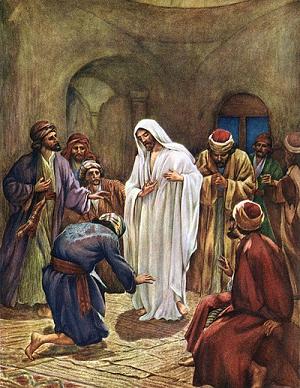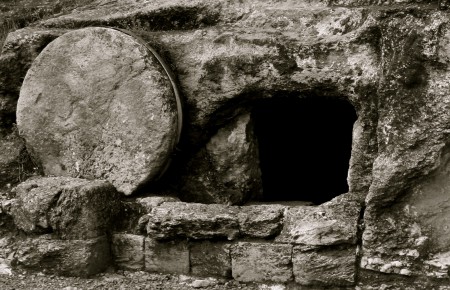What are Counterfeit Gospels
3. The Gospel is the Proclamation of the Fact that Jesus Rose again from the Dead, Never to Die Again

The resurrection of Jesus Christ is one of (3) possibilities:
1. Fact – It actually, literally occurred.
2. False – It is a lie, a fabrication or a hoax.
3. Fiction – It is the end result of a mythological, legendary process.
When we examine the record of the book of Acts and the entire New Testament, the centrality of the resurrection cannot be overstated. It is the cornerstone event of the Gospel, the confirmation that Jesus Christ has the right and authority to forgive our sins through His death for us on the cross and that He is Lord over all things.Philip Schaff, the highly respected church historian stated – “The resurrection of Christ is therefore emphatically a test question upon which depends the truth or falsehood of the Christian religion. It is either the greatest miracle or the greatest delusion which history records”.
A. The Gospel affirms that Jesus predicted His death and resurrection
See the following passages – Matthew 12:38-40; 16:21-28; 17:7-17,22,23; 20:17-19; Mark 8:31-33; 9:9,10,31,32; 10:32-39; 14:27-31; Luke 9:22, 43-45; 11: 29,30; 17:25; John 2:18-22; 3:14-16: 12:32,33;“From that time Jesus began to show His disciples that He must go to Jerusalem and suffer many things from the elders and chief priests and scribes, and be killed and be raised on the third day.” – Matthew 16:21.“… we are going up to Jerusalem, and the Son of Man will be betrayed to the chief priests and to the scribes and they will condemn Him to death and deliver Him to the Gentiles (Romans) to mock and to scourge and to crucify. And the third day He will rise again” – Matthew 20:18,19.
“So the Jews answered and said to Him. What sign do you show us, since You do these things? Jesus answered and said to them; Destroy this temple and in three days I will raise it up. Then the Jews said, It has taken forty six years to build this temple and You will raise it up in three days? But He was speaking of the temple of His body. Therefore when He had risen from the dead His disciples remembered that He had said this to them; and they believed the Scripture and the word which Jesus had said” – John 2:18-22.
After Jesus had previously made numerous references to His disciples that He would suffer, die and rise from the dead, the angel at the empty tomb after the resurrection event told the women who came with burial spices- “He is not here, but He is risen! Remember how He spoke to you in Galilee, saying; The Son of Man must be delivered into the hands of sinful men and be crucified and on the third day rise again. And they remembered His words” – Luke 24:6-8. When the women reported the words of the angel and the news of the resurrection of Christ, the disciples’ response was – “And their words seemed to them like idle tales and they did not believe them” – Luke 24:11.
When the disciples finally saw the empty tomb for themselves, they still did not know what to make of it and Thomas refused to believe until he touched Jesus’ wounds. Their response confirms that Jesus predicted these events but they did not believe because they could not in their defeated and discouraged condition – John 20:9,24-25. The response of the accusers at Jesus’ trial also indicates that they had heard the prediction that Jesus provided found in John 2:18-22 even though they had misinterpreted it.
“For many bore false witness against Him, but their testimonies did not agree. Then some rose up and bore false witness against Him saying; We heard Him say – I will destroy this temple made with hands and within three days I will build another made without hands. But not even then did their testimony agree” – Mark 14:56-59.These passages argue for the early prediction by Jesus Christ of both His suffering and death and His resurrection.
B. The Gospel affirms that Jesus Provided the Meaning of His Death and Resurrection

See the following passages – Mark 10:45; 14:22-24; Luke 22:19,20: 24:25-27; 44-48; John 6:30-33, 48-51; 10:11,15; 12:23,24,32-34; 13:31-33; 14:19.
Jesus said regarding His death on the cross
“For even the Son of Man did not come to be served, but to serve and to give His life as a ransom( to secure the release)for many” – Mark 10:45.“And He took bread and broke it and gave it to them saying – This is my body which is given for you; do this in remembrance of Me. Likewise He also took the cup after supper saying, This cup is the new covenant in My blood which is shed for you” – Luke 22:19,20.“I am the good shepherd. The good shepherd gives His life for the sheep. Therefore My Father loves Me because I lay down My life (death) that I may take it again (resurrection)” – John 10:11,17.These passages confirm that Jesus defined His death on the cross as a sacrifice for us, as the payment to secure our release from the penalty of sin.Jesus also stated what His resurrection would mean:
“I Am the Resurrection and the Life. He that believes in Me (I AM the LORD), though he may die, yet shall He live and whoever lives and believes in Me will never die” – John 11:25,26.Why is the resurrection is so central to the Gospel? Because it is through the resurrection that Jesus Christ has proven to have accomplished the saving merits of the cross. If Jesus did not rise from the dead, the cross would be a failure and Jesus Christ could not have been Who He claimed to be – The Lord.C. The Gospel affirms that Jesus had the power to lay down His life ( His death on the cross) and that He had the power to take it back again ( His resurrection from the dead). See these passages – John 2:19; 10:17,18.Jesus said:

“Destroy this temple (My body) and in three days I will raise it up” – John 2:19.“Therefore My Father loves Me, because I lay down My life (death) that I may take it back again (resurrection). No one takes it (My life)from Me but I lay it down of Myself. I have power to lay it down (in death) and I have power to take it again (in resurrection life ). This command I have received from My Father” – John 10:17,18.
Jesus stated prior to His death that he would freely lay His life down in death and then take it back again in resurrection life. He affirmed that this was based on His own authority and power. This is an amazing claim and it opens the door to examination and to the possibility of falsification. To claim that if He does resurrect from the dead (a monumental feat) He will have done so by His own power is an event, that if it indeed did occur, vindicates His claims.According to the Gospel, Jesus predicted His suffering and death on the cross and then He defined what His death would mean-Mark 10:45, John 10:11,17.
Next, He predicted His resurrection and stated that He had the power and authority to not only lay down His life with the death on the cross but that He also had the power to resurrect from the grave. Jesus emphasized that His resurrection from the dead would be a “sign” that would authenticate His claim to be the Messiah and Lord – John 2:18-22; Matthew 12:38-40. Then He died, was buried in a tomb and on the third day He rose from the dead never to die again. Now that is an accomplishment! Who else but the Lord of Life could do this? Someone living today, 2,000 years removed the resurrection event, may come up with their own idea as to what the cross and resurrection means. But we should let the One who actually predicted His death and resurrection and then by His own power rise from the dead be the Person to provide the definition.
The word resurrection means – “to come out from among the dead ones”. In the case of Jesus Christ, the Gospel record states that He died, was buried in a grave for three days and then came back to life again. His resurrection is unlike any other resurrection ever recorded in Bible history in that He rose from the dead by His own power and never died again. In all other cases of resurrections recorded in the Bible (three in the Old Testament and five in the New Testament), this was not the manner in which people came back to life. They were raised by God’s intervention (not by their own power or volition) and later in life died. It would be more correct to refer to these resurrections as resuscitations with the exception of Jesus’ raising of Lazarus – John 11 and the raising of the bodies recorded in Matthew 27:52,53.The apostles and early church preachers of the Gospel appealed to eyewitness testimony and affirmed that Jesus did indeed rise from the dead.
The records of the four Gospels affirm that Jesus appeared to numerous individuals, some believers and others who were skeptical and even antagonists of the resurrection claim.
The following is a summary listing of the recorded appearances of the risen Christ to various people:

1 To Mary Magdalene at the tomb on Sunday – Mark 16:6; John 20:11-18
2 To the women returning from the tomb on Sunday – Matthew 28:8-10
3 To Peter on Sunday– I Corinthians 15:5; Luke 24:34
4 To the disciples on the road to Emmaus on Sunday evening – Mark 16:12; Luke 24:13-32
5 To the disciples with Thomas absent late Sunday evening–Mark 16:14; Luke 24:33-49; John 20:19-25
6 To the disciples with Thomas present eight days later – John 20:26-31, I Corinthians 15:5
7 To the seven disciples at the Sea of Galilee – John 21:1-19
8 To the apostles and over 500 brethren in Galilee – I Corinthians 15:6; Matthew 28:16-20; Mark 16:15-18
9 To a skeptical James, Jesus’ brother – I Corinthians 15:7
10 To the crowd of disciples and others at the Ascension from the Mount of Olives – Mark 16:19,20; Luke 24:44-53; Acts 1:3-12
11 To an adversary of the Gospel – Paul – I Corinthians 15: 8.
Although it did not describe the resurrection appearance of the risen Christ, the report of the guards, who ran from the tomb in fear includes their witness of the earthquake, the appearance of the angels and the reality that the stone was rolled away – Matthew 28:1-4, 11-15. The guards reported these events to the chief priests and they were given a large sum of money to tell their superiors that Jesus’ disciples stole the body at night while they slept. The chief priests agreed to appease Pilate if he heard of this incident.- Matthew 28:11-15. This is a clear example of enemy attestation that supports the claim of the empty tomb.

The appearances of the risen Jesus to His disciples and various individuals took place over a span of 40 days – Acts 1:1-9. The author of the book of Acts (Luke) provides the following information regarding these appearances.
“The former account I made to Theophilus of all that Jesus began both to do and teach, until the day in which He was taken up, after He through the Holy Spirit had given commandments to the apostles whom He had chosen, to whom He also presented Himself alive after His suffering by many infallible proofs, being seen by them during forty days and speaking of the things pertaining to the kingdom of God”. – Acts 1:1-3
The author of this account is the physician (Col. 4:14) and companion (Philemon 24) of the apostle Paul – Luke. He refers to the “former account”, which was the first narrative that he had written earlier to Theophilus that we know today as the Gospel of Luke. “Inasmuch as many have taken in hand to set in order a narrative of those things which have been fulfilled among us, just as those who from the beginning were eyewitnesses and ministers of the word delivered them to us, it seemed good to me also, having had perfect understanding of all things from the very first, to write to you an orderly account, most excellent Theophilus, that you may know the certainty of those things in which you were instructed” – Luke 1;1-4.Luke writes both of these two accounts to Theophilus and provides “eyewitness” information so that Theophilus can have an “orderly account” and “know with certainty” the things of the Gospel that he had been instructed in. Luke asserts that he “had perfect understanding of all things from the very first” and on the basis of this knowledge he writes this “orderly account’.The apostle John also states very clearly in His Gospel and letters that He was an eyewitness to the events of Christ’s life and ministry; that he was there at the cross and at the empty tomb. He makes it clear to the readers that he saw and touched the risen Jesus Christ. – John 13:23; 19:26,35;20:2;21:17,20; I John 1:1-4.
“And he who has seen has testified and his testimony is true: and he knows that he is telling you the truth so that you may believe”. – John 19:35“That which was from the beginning, which we have heard, which we have seen with our eyes, which we have looked upon and our hands have handled concerning the Word of life (Jesus Christ John 1:1-14)” – I John 1:1The apostle Peter provides the same type of affirming statement when he says -rn“For we did not follow cunningly devised fables when we made known to you the power and coming of our Lord Jesus Christ, but we were eyewitnesses of His majesty”. – II Peter 1:16
The apostle Paul refers to the message of the Gospel and the resurrection that He had received – “For I delivered to you first of all that which I also received: that Christ died for our sins according to the Scriptures, and that He was buried and that He rose again the third day according to the Scriptures and that He was seen…..”
Paul then proceeds to list several of the appearances of Jesus to various individuals. This passage is one of the earliest and most significant creeds found in the New Testament and it is considered by New Testament scholars to probably have been developed within 3-5 years of the resurrection and ascension of Christ. The book of I Corinthians was probably written between A.D. 55-56 within 25 years of the resurrection of Christ and this creed then links back even further to within 3-5 years. Here the apostle Paul says I “delivered to you first of all that which I also received” and he proceeds to present the creed of Christ’s death, burial and resurrection. He was passing on to the Corinthians the Gospel of the resurrection that he had been given linked back to very early testimony.When we look at the preaching in the book of Acts, one outstanding feature of their presentation of the Gospel and the resurrection was that it was based on eyewitness testimony. The early preachers of the Gospel were saying that this event literally happened as seen by eyewitness testimony; it is not speculation or theory or fiction.
In many cases, as the apostles and other eyewitnesses proclaimed the resurrection, they appealed to their own eyewitness testimony and in some cases ( in Jerusalem) to common public knowledge. “This Jesus has God raised up of which we are all witnesses” – Acts 2:32.

“ …whom God has raised from the dead, of which we are witnesses” – Acts 3:15.“For we cannot but speak of the things which we have seen and heard” – Acts 4:20.“The God of our fathers raised up Jesus whom you murdered by hanging on a tree. Him God has exalted to His right hand to be Prince and Savior, to give repentance to Israel and forgiveness of sins. And we are His witnesses to these things…” – Acts 5:30-32.
“Him God raised up on the third day and showed Him openly, not to all the people, but to witnesses chosen before by God, even to us who ate and drank with Him after He arose from the dead” – Acts 10:40,41.
“But God raised Him from the dead. He was seen for many days by those who came up from Galilee to Jerusalem, who are His witnesses to the people” – Acts 13:30, 31. When Paul relates his encounter with the risen Christ to Ananias, Ananias confirms to Paul that he has been chosen to be a witness of the resurrection
–“Then he (Ananias) said, ‘The God of your fathers has chosen you that you should know His will, and see the Just One (Jesus) and hear the voice of His mouth. For you will be His witness to all men of what you have seen and heard” – Acts 22:14,15.Paul becomes the most prominent missionary/apostle to the Gentile (non-Jewish) world. He preaches the Gospel and the resurrection of Christ in numerous cities, including many audiences with philosophers and religious and civic rulers. He stands before two rulers – King Agrippa and Festus and presents his testimony of the Gospel and of his encounter with the risen Jesus. Festus’s response to Paul was – “Now as he thus made his defense, Festus said with a loud voice, ‘Paul, you are beside yourself! Much learning has made you mad! But he (Paul) said, ‘I am not mad, most noble Festus, but speak the words of truth and reason. For the king, before whom I also speak freely, knows these things; for I am convinced that none of these things escapes his attention, since this thing was not done in a corner” – Acts 26:24-27
Why is the resurrection so important to the proclamation and defense of the Gospel?
The Gospel of Jesus Christ is the good news that everyone needs to hear. Simply stated, the Gospel claims that through faith in Jesus’ death for us on the cross we can have forgiveness of sin and eternal life.
The (3) primary facts of the Gospel are:
1. Jesus Christ is God – (The Lord)
2. Jesus Christ is our Savior Who died for our sin – (in our place)
3. Jesus Christ is the Giver of eternal life Who rose from the dead – ( never to die again).
The clearest example of these essentials are found in (2) passages in the New Testament. I Corinthians 15: 3-5. “For I delivered to you first of all that which I also received: that Christ died for our sins according to the Scriptures and that He was buried and that He rose again the third day according to the Scriptures and that He was seen….”Romans 10:8,9,13 – “What does it (the Gospel) say? The word is near you in your mouth and in your heart, that is the word of faith which we preach: That if you confess with your mouth the Lord Jesus Christ and believe in your heart that God raised Him from the dead you will be saved. For whoever calls on the name of the Lord will be saved”. To believe the Gospel we must first acknowledge that we are sinners and need the Savior (Jesus Christ).
Second, we believe and confess that Jesus Christ is the Sovereign Lord of all, the Divine Son of God and Savior who died for our sins and in our place and then rose from the dead. Last, we must turn from our sin (independence from God, our self-directed life and actions) and trust in Jesus Christ as our Lord and Savior. When we do this, the Scriptures tell us our sins are forgiven and we have eternal life – John 5:24.The resurrection is the seal and witness that Jesus Christ’s accomplishment on the cross on our behalf was effective. Our sins were paid in full by Jesus’ death on the cross and the resurrection from the dead is the visible assurance that we are forgiven.
The apostle Paul conveyed the importance of the resurrection of Christ in the lives of all believers in Jesus – “But if there is no resurrection from the dead, then Christ is not risen. And if Christ is not risen, then our preaching is empty and your faith is also empty. Yes, and we are found false witnesses of God, because we have testified of God that He raised up Christ, whom He did not raise up – if in fact the dead do not rise. And if the dead do not rise, then Christ is not risen. And if Christ is not risen, your faith is futile; you are still in your sins! Then also those who have fallen asleep in Christ(believers who have died) have perished. If in this life only we have hope in Christ, we are of all men the most pitiable. But now Christ is risen from the dead…” – I Corinthians 15:12-19
The apostle Paul continues in I Corinthians 15 and makes it clear that a resurrection is always a bodily resurrection. The body that goes into the tomb is changed and resurrected into a new non-perishing body. He makes the point that Jesus Christ’s resurrection consisted of His earthly body that was changed from a perishing body to a non-perishable one. The resurrection of Christ was not some type of mystical, spiritual manifestation but rather was a rising of the dead body that was placed in the tomb to a new life in a new body that would never die. This same promise of a resurrected body is extended to all believers in Jesus, that like our Savior and Lord , we will be changed from a perishable body to an imperishable one through the victory accomplished for us by Jesus Christ – I Corinthians 15:20, 50-52.
Jesus’ resurrection body was in some very real way altered from His previous body. In many of His appearances to individuals, they did not recognize Him at first. Although His body was real and of human flesh, it was different in some very mysterious ways. He was capable of eating food and He could be touched and handled; His wounds in His hands and feet were still present, yet He could appear and disappear instantly and could enter a room through the walls or exit out of a room as He did in the tomb. (The stone was rolled away not to let Jesus out but to let witnesses in). He could ascend to heaven and cover large distances of travel instantly, yet He was not a ghost or a spirit. If Jesus did rise again from the dead (never to die again), we would expect that His body would have to very different from the aging and dying bodies that all human beings have. This body that Jesus had was in so many ways different than His previous body that it did present a difficulty for the disciples to understand and easily recognize Him. This partly explains some of their doubt ,fear and inability to embrace Him.

The Gospel accounts clearly report that Jesus’ body was not a spirit or a mystical manifestation. The disciple Thomas was the disciple of Christ that maintained that he had to physically see and touch the real Jesus in order for him to believe in the resurrection. He wanted to see the real body of Jesus. This is what the Biblical understanding of what a resurrection would be. It would have to be a visible, bodily resurrection and if it was not, then it wasn’t a resurrection. In John’s Gospel, Jesus appears to the disciples with Thomas present. “And after eight days His disciples were again inside and Thomas with them. Jesus came, the doors being shut and stood in the midst and said ‘Peace to you’. Then He said to Thomas, Reach your finger here and look at My hands and reach your hand here and put it into My side. Do not be unbelieving, but believe. And Thomas answered and said to Him,’ My Lord and My God’. Jesus said to Him, Thomas, because you have seen Me, you have believed. Blessed are those who have not seen and yet have believed”. – John 20:26-29. Any attempt to make the appearance of Christ a non-physical or mystical experience has to call the eyewitness accounts of the Gospel into question. The New Testament recorded (3) times that the disciples touched Jesus – Matthew 28:9; Luke 24:39; John 20:27, and (2) times either stated or implied that He ate with them – Luke 24:52; John 21:12,13.
This is not what takes place with a spirit or a vision, but rather this is something that takes place with a person in a body .The Gospel writers absolutely affirm that Jesus rose from the dead in bodily form and they made it clear that this affirmation was central to following Jesus Christ. To deny the resurrection would be to deny Christ.